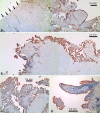Distribution of lubricin in the ruptured human rotator cuff and biceps tendon: a pilot study
- PMID: 19798542
- PMCID: PMC2865589
- DOI: 10.1007/s11999-009-1108-z
Distribution of lubricin in the ruptured human rotator cuff and biceps tendon: a pilot study
Abstract
Background: Lubricin is a lubricant for diarthrodial joint tissues and has antiadhesion properties; its presence in the (caprine) rotator cuff suggests it may have a role in intrafascicular lubrication.
Questions/purposes: To preliminarily address this role, we asked: (1) What is the distribution of lubricin in human ruptured supraspinatus and biceps tendons? (2) What are the potential cellular sources of lubricin?
Methods: We obtained seven torn rotator cuff samples and four torn biceps tendon samples from 10 patients; as control tissues, we obtained the right and left supraspinatus tendons from each of six cadavers. Specimens were fixed in formalin and processed for immunohistochemical evaluation using a monoclonal antibody for lubricin.
Results: We found lubricin as a discrete layer on the torn edges of all of the ruptured supraspinatus and biceps tendon samples. None of the transected edges of the tissues produced during excision of the tissues showed the presence of lubricin. Lubricin was found in 3% to 10% of the tendon cells in the cadaveric controls and in 1% to 29% of the tendon cells in the torn supraspinatus and biceps tendon samples.
Clinical relevance: The lubricin layer on the torn edges of ruptured human supraspinatus and biceps tendons may interfere with the integrative bonding of the torn edges necessary for repair.
Figures




Similar articles
-
Glycosaminoglycans of human rotator cuff tendons: changes with age and in chronic rotator cuff tendinitis.Ann Rheum Dis. 1994 Jun;53(6):367-76. doi: 10.1136/ard.53.6.367. Ann Rheum Dis. 1994. PMID: 8037495 Free PMC article.
-
Tendon degeneration and chronic shoulder pain: changes in the collagen composition of the human rotator cuff tendons in rotator cuff tendinitis.Ann Rheum Dis. 1994 Jun;53(6):359-66. doi: 10.1136/ard.53.6.359. Ann Rheum Dis. 1994. PMID: 8037494 Free PMC article.
-
Localized Rotator Cuff Tendon Degeneration for Cadaveric Shoulders with and Without Tears Isolated to the Supraspinatus Tendon.Clin Anat. 2020 Oct;33(7):1007-1013. doi: 10.1002/ca.23526. Epub 2019 Dec 2. Clin Anat. 2020. PMID: 31750575
-
Histopathology of rotator cuff tears.Sports Med Arthrosc Rev. 2011 Sep;19(3):227-36. doi: 10.1097/JSA.0b013e318213bccb. Sports Med Arthrosc Rev. 2011. PMID: 21822106 Review.
-
Proximal Biceps Tendon and Rotator Cuff Tears.Clin Sports Med. 2016 Jan;35(1):153-61. doi: 10.1016/j.csm.2015.08.010. Epub 2015 Sep 26. Clin Sports Med. 2016. PMID: 26614474 Review.
Cited by
-
Tendon and ligament regeneration and repair: clinical relevance and developmental paradigm.Birth Defects Res C Embryo Today. 2013 Sep;99(3):203-222. doi: 10.1002/bdrc.21041. Birth Defects Res C Embryo Today. 2013. PMID: 24078497 Free PMC article. Review.
-
Lubricin Distribution in the Menisci and Labra of Human Osteoarthritic Joints.Cartilage. 2012 Apr;3(2):165-72. doi: 10.1177/1947603511429699. Cartilage. 2012. PMID: 26069629 Free PMC article.
-
Mini-open transosseous repair with bursal augmentation improves outcomes in massive rotator cuff tears.Sci Rep. 2025 Jan 17;15(1):2333. doi: 10.1038/s41598-025-85520-2. Sci Rep. 2025. PMID: 39824871 Free PMC article.
-
Murine supraspinatus tendon injury model to identify the cellular origins of rotator cuff healing.Connect Tissue Res. 2016 Nov;57(6):507-515. doi: 10.1080/03008207.2016.1189910. Epub 2016 May 16. Connect Tissue Res. 2016. PMID: 27184388 Free PMC article.
-
Lubricin: Its Presence in Repair Cartilage following Treatment with Autologous Chondrocyte Implantation.Cartilage. 2010 Oct;1(4):298-305. doi: 10.1177/1947603510370156. Cartilage. 2010. PMID: 26069560 Free PMC article.
References
-
- Codman EA. The Shoulder. Boston, MA: Thomas Todd; 1934.
-
- Craig E. Open anterior acromioplasty for full thickness rotator cuff tears. In: Craig E, ed. The Shoulder. New York, NY: Rowan Press; 1995:21–27.
Publication types
MeSH terms
Substances
LinkOut - more resources
Full Text Sources

